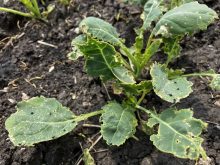[UPDATED: June 2, 2020] Potential frost damage might be the least of the many crop stressors Manitoba farmers see as they scout their fields the next several days.
“Frost is just one of the factors we’re looking for right now,” Anastasia Kubinec, Manitoba Agriculture and Resource Development’s (MARD) Manager of Crop Industry Development, said in an interview June 1. “Folks need to be diligent at looking in their fields or having their agronomists looking for wind shearing, flea beetle damage in canola and potential cutworm feeding and then some of these environment factors like frost.”
Read Also

Critical growing season is ahead for soybeans
What the weather turns out to be in the United States is going to have a significant impact on Canadian producers’ prices
Freezing temperatures were recorded in much of agro-Manitoba early May 30, MARD’s weather stations show. Fortunately, most newly-emerged annual crops weren’t damaged or suffered just light damage, Kubinec said.
“There might be a few fields guys are still assessing, but for the most part I don’t think it got cold enough,” she said. “I think the issues with re-seeding are more with running into really, really wet soils and then it got dry and packed, or with these really warm days and excessive winds we have wind shearing going on. Frost would be an additional stress, and flea beetles in canola, and there are cutworms out as well.”
*The May 30 frost damaged some alfalfa in the St. Laurent area one farmer said on Facebook June 2. The hay crop there needs rain, the farmer added. The Manitoba Co-operator is investigating the condition the province’s hay crop and will post an update soon.
Why it matters: Many Manitoba crops, already off to a slow start. While frost on May 30 might not have killed many crops outright it’s one more stress along with packed soils, flea beetles, cut worms and hot, dry winds.
The amount of frost damage varies with how cold it got and for how long. Some crops are also more frost tolerant. For example frozen cereals seedlings will re-grow after losing leaves, because their growing point is below the soil.
Edible beans and soybeans are much less frost tolerant.
Canola is susceptible to frost too.
Usually 48 hours after frost seedling plant leaves will appear water-soaked, Kubinec said.
“Two hot, windy, sunny days (like Sunday and Monday) will definitely desiccate them if they were toast,” she added.
Although freezing temperatures were recorded across much of agro-Manitoba early May 30, most stations were no colder than -2 C, for one to four hours.
There were exceptions though including -4.4 C for five hours at Sprague Lake, and -4.2 C and -3.7 C for seven hours at Marchand and Narcisse.
Jason Voogt of Field 2 Field Agronomy was seeing frost damaged canola in the Carman and Elm Creek areas Monday morning (June 1), but not enough to warrant reseeding, he said in an interview. Some corn leaves were singed as well, but the plants will survive, he said.

Like Kubinec, Voogt said farmers should be checking fields for flea beetles and cutworms.
“We are really starting to notice more flea beetle activity since the heat came around last week,” he said in an interview June 1. “We had those two cooler days last week then it got warm again and everything has just taken off. It’s not general, but we are seeing a number of fields around Carman, Elm Creek and out to Starbuck getting sprayed for flea beetles. In some cases it’s whole fields and in some cases borders, but what we’re noticing in just a day or two a field can go from looking just perfect to having quite a bit of feeding going on, so we’re continuing to monitor.”
Voogt tweeted that frost damage could attack even more flea beetles because it releases a pheromone called allyl-isothiocyanate.
“Highly concentrated, it smells like horseradish,” he wrote. “Not that canola needed a cologne or anything to attract flea beetles, just sayin (sic).”
Neonicotinoid canola seed treatments such as Helix and Prosper provide three to four weeks of protection against flea beetle feeding from the time of planting, MARD entomologist John Gavloski said in an interview June 1.
“For people who seeded into warm soil with good moisture those seed treatments might be all they need,” he said. “The problem is any canola, because of stressful conditions, sits in that seedling stage for more than three weeks you have to be scouting for flea beetles because they are another potential threat. If frost or dry conditions or basically any stress sets it back and keeps it in that seedling stage for a prolonged period that just makes it more susceptible to flea beetle feeding. I know there already have been a few fields sprayed for flea beetles.”
Thanks to warmer temperature forecast this week, canola fields with good moisture could soon grow less susceptible to flea beetle, Gavloski said.
Cutworms are showing up in some fields and some fields have been sprayed, he said.
Neonic canola seed treatments don’t control cutworms very well, he added. However, Lumiderm and Fortenza Advanced, two other canola seed treatments, do.
Lumivia is a cutworm seed treatment available in cereal crops and pea; Fortenza Advanced is also registered for corn, Gavloski said.
“Last year was a fairly bad cutworm year so this year there is probably going to be more people using these seed treatment products for cutworms,” he said.
Wilting sunflowers could be because of cutworms and not frost, Kubinec said.
“A picture I saw showed one (sunflower) wilted and one perfectly fine,” she said. “That’s a give away that it’s not necessarily frost because you have two plants side-by-side and one is fine and one is not, so something else is going on.”
Voogt is seeing some re-seeding in the Fannystelle-Starbuck area due to hard-packed soils affecting emergence following a heavy rain May 23.
“A lot of producers were thinking because seeding was delayed maybe we missed the insects but it’s not the cases because they emerge based on growing degree days so everything has just shifted, including the insects,” he said.
*Update: mention of impact on alfalfa/hay crops was added for the May 30 frost event.




















